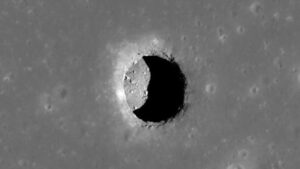An enormous black hole has left the center of its home galaxy and is hurtling through space at a rate of 5.6 million kph.
In its wake, the supermassive object is trailing a long strand of star-forming gases. That’s how Pieter van Dokkum, a professor of physics and astronomy at Yale University, was able to spot it, according to Live Science.
The gas trail is twice the length of our own galaxy. It goes to show that when you are talking about space, there’s just no way to wrap your head around the distances at play. And in an era where the James Webb Telescope seems to make news every few weeks, let’s raise a glass to the Hubble Telescope — the original intergalactic looking glass.
“We found a thin line in a Hubble image that is pointing to the center of a galaxy,” van Dokkum told LiveScience. “Using the Keck telescope in Hawaii, we found that the line and the galaxy are connected. From a detailed analysis of the feature, we inferred that we are seeing a very massive black hole that was ejected from the galaxy, leaving a trail of gas and newly formed stars in its wake.”

An illustration of how (possibly) a supermassive black hole came to be hurtling through space. Two supermassive black holes existed in peace with each other until their galaxy gobbled up a second galaxy. The supermassive black hole at the center of the second galaxy disturbed the balance of the first two, ejecting one of them out into the cosmos. Photo: van Dokkum et al
Escape from the dwarf galaxy
The dwarf galaxy in question is 7.5 billion light years from our planet. Like most galaxies, it likely held a supermassive black hole at its center. It’s not uncommon for supermassive black holes to launch “astrophysical jets” of material into space. But Dokkum and his team had a hunch that’s not what they were looking at.
The “thin line” the scientists observed had different characteristics than an astrophysical jet. Notably, it didn’t fan out into space, and it got brighter farther away from its point of origin. The best explanation is that a supermassive black hole is on a tear through the gas surrounding its former home galaxy.
“If confirmed, it would be the first time that we have clear evidence that supermassive black holes can escape from galaxies,” van Dokkum said.
Cosmic shuffling
But how could such a thing happen? That’s the tricky part.
Van Dokkum told Live Science that one explanation could be “a three-body interaction.” This is where two supermassive black holes in a tenuous balance were disturbed by a third.
Two supermassive black holes in the center of a galaxy are rare. The introduction of a third is likely the result of galaxy mergers sometime in the distant past, van Dokkum said. After some cosmic shuffling between all three black holes, one of the original binary black holes likely got slingshot out into the great empty.

An example of galaxies colliding. Something like this probably occurred to allow the ejection of a supermassive black hole from a rare binary black-hole galaxy. Photo: Shutterstock
Van Dokkum and his team submitted their findings to The Astrophysical Journal Letters. The paper is currently available on the pre-print server arXiv.org.
As it stands, van Dokkum said, observation from other telescopes is needed before his team can directly confirm its hypothesis.






